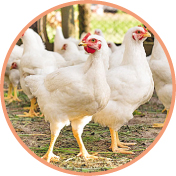
Making broiler meat safe for human consumption
Nilratan Halder | Friday, 7 April 2023
 Broiler chicken has been making screaming headlines for sometime now. First, it was the record price hike of the cheapest source of animal protein and then because of the drastic cut in prices following a meeting between the Consumer Protection Rights Department (CPRD) and the big four poultry farm companies. Reportedly, the small and marginal farmers have been badly affected because of the latest move by the big companies to sell broilers at prices lower than the production cost.
Broiler chicken has been making screaming headlines for sometime now. First, it was the record price hike of the cheapest source of animal protein and then because of the drastic cut in prices following a meeting between the Consumer Protection Rights Department (CPRD) and the big four poultry farm companies. Reportedly, the small and marginal farmers have been badly affected because of the latest move by the big companies to sell broilers at prices lower than the production cost.
But why? Have the poultry sharks suddenly been imbued with the spirit of the holy month of Ramadan to become so generous as to do some charity service for the needy and vulnerable? The marginal poultry farmers complain that it is another kind of business syndication aimed at creating a trade regime where the small farmers go broke. If they are compelled to sell broilers incurring losses for sometime, it will be beyond their power to stay in business. It seems the members of the syndicate have a vicious trick up their sleeves.
However, this particular variety of chicken has given rise to even more disturbing news and it concerns the safety of its meat. When the issue of food safety comes to the fore, usually adulteration, unhygienic preparation and use of harmful and non-food grade colours are brought under the scanner. Only rarely are the animal feed and hormone-enhancing antibiotic or substances placed under rigorous scrutiny.
Also when laboratory tests come up with results showing presence of harmful substances in products or feed posing threat to public health, the issue is not pursued further and the news is killed somehow or other. What happened to the pasteurised packet milk following the alarming revelation in laboratory tests may be a case in point. There was just a brief news bite claiming that such packet milk of different companies proved safe for consumption in a laboratory test in Chennai, India. Are the tests in the country's laboratories, including that of Dhaka University, erroneous?
It is against this backdrop, the latest study by a final-year student of Khulna University, as reported, hardly stands a chance of receiving the attention and having the follow-up it deserves. But it should. The dissertation titled "Assessment of heavy metal in broiler chicken and its source tracking in Khulna City Corporation area" prepared under the supervision of Dr. Abdulla Harun Chowdhury, Head of the Environmental Science discipline of Khulna University presents an alarming picture. His study carried out throughout 2022 finds the presence of excessively high amount of heavy metals like nickel, chromium, lead and arsenic in both broiler meat and poultry feed from 15 companies he collected from Nirala, Moilapota, Rupsa, New Market and Boira Bazar.
The World Health Organisation (WHO)-recommended level of nickel in each kilogram of broiler meat is 0.50 milligram but his sample showed 128 mg in meat and 79 mg in bones. Similarly, against the WHO-recommended 1.0 mg of chromium, there were 12.5 and 10.45 mgs respectively in meat and bones. Again, against 0.10 mg of lead, meat and bones had 18.52 mg and 3.79 mg respectively. Thus arsenic's presence is 0.83 mg in meat and 0.37 mg in bones as against 0.10.
The WHO does not recommend any level of heavy metals' presence in poultry feed. This means the feed has to be free of any such substance. But the highest level of nickel in poultry feed was found to be 1.93 mg, chromium 60.58 mg and lead 5.86 mg in each kg. The European Commission poultry feed regulations (2003) recommends no more than 0.05 mg of lead in a kilogram of such feed.
Understandably, the problem is not with the broiler chicken; it is with the feed which uses ingredients that contain those harmful heavy metals. Even fish and poultry feeds made news when it was found that leather factories' rejects were used to prepare those. The question is, if companies follow the standard practice while producing fish and poultry feeds. The teacher of Khulna University, who supervised the study sounded condescending when he remarked that small farmers either unaware of the consequences or for higher profit might have used low quality feed. What matters here is the production of quality feed and its rigorous inspection so that substandard type cannot be marketed.
The most important question here is to know if the feed-related hazard from broiler chicken is confined only to Khulna City or it is more or less a problem all across the country. To know this there is a need for an extensive study to be carried out by a competent researcher or research team under a reputed organisation. The rumpus over the soaring price over this cheap source of animal protein was quite expected but if it proves harmful to human health, remedial measures have to be taken urgently before the poisonous substances present in meat get circulated through the food chain and cause irreparable damage to nation's health. Standardisation of poultry feed which is the source of poisoning will be the key. Otherwise, the dangerous substances found in poultry feed will continue to, as physicians attest to the fact, damage liver, kidney and brain in human body.